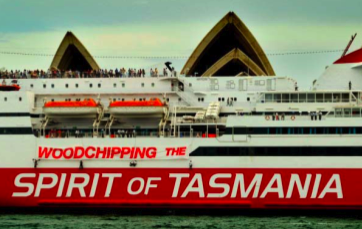No – advertising has not beaten culture jamming at its own game
 In this guest post, an anonymous activist argues why advertising has not subverted culture jamming – and why Australia would be a better place without ‘visual pollution’
In this guest post, an anonymous activist argues why advertising has not subverted culture jamming – and why Australia would be a better place without ‘visual pollution’
At a photography exhibition now on the Sydney Museum last week, a question was put to a panel of experts. Would our cities be better without any advertising. The answer was a resounding “yes”.
This didn’t really come as much of a surprise. After all, the panel were culture jammers – activists who subvert mainstream media, altering the message of an ad to tell a story of their own.
The term culture jamming is associated with the rise of anti-globalisation and a backlash against rising consumerism and the power of brands during the nineties and noughties.
But of course subverting a dominant culture is as old as culture itself.
 On the panel was one of the activists who painted ‘No War’ on the Opera House, a few members of ‘The Lonely Station’, a Sydney-based culture jamming outfit best known for adding the words “Woodchipping the” to the Spirit of Tasmania cruise ship, Buga Up (short for Billboard Utilising Graffitists Against Unhealthy Promotions), an informal collective who targeted tobacco billboards in the 70’s and 80’s and Dean Sewell, a well-known Sydney Morning Herald photographer who has documented culture jamming.
On the panel was one of the activists who painted ‘No War’ on the Opera House, a few members of ‘The Lonely Station’, a Sydney-based culture jamming outfit best known for adding the words “Woodchipping the” to the Spirit of Tasmania cruise ship, Buga Up (short for Billboard Utilising Graffitists Against Unhealthy Promotions), an informal collective who targeted tobacco billboards in the 70’s and 80’s and Dean Sewell, a well-known Sydney Morning Herald photographer who has documented culture jamming.
 In the mid-2000s I was part of The Lonely Station, a small bunch of activists fed-up with many of the issues people get fed up with. A senseless war in Iraq. The inhumane treatment of refugees. The plundering of our natural environment. And the intrusion of advertisements into almost every conceivable public space.
In the mid-2000s I was part of The Lonely Station, a small bunch of activists fed-up with many of the issues people get fed up with. A senseless war in Iraq. The inhumane treatment of refugees. The plundering of our natural environment. And the intrusion of advertisements into almost every conceivable public space.
 We took to the streets at night and scaled billboards to subvert messages and images that had been used to distract the minds of millions from their personal thoughts to the banalities of how cool it would be to own lingerie that cost half a day’s wages, or the increased social standing from owning a larger car with a bit more grunt.
We took to the streets at night and scaled billboards to subvert messages and images that had been used to distract the minds of millions from their personal thoughts to the banalities of how cool it would be to own lingerie that cost half a day’s wages, or the increased social standing from owning a larger car with a bit more grunt.
 The changes we made usually only lasted a few days. Sometimes just hours. But we hoped this gave some food for thought to passers-by. And Dean was there to capture the image.
The changes we made usually only lasted a few days. Sometimes just hours. But we hoped this gave some food for thought to passers-by. And Dean was there to capture the image.
In at least one review of the exhibition (an article in the Herald particularly riles me) it’s been said that advertising has co-opted culture jamming.
Gruen Transfer regular Jane Caro was quoted as saying:
Advertising, being completely amoral, will latch onto anything that might catch someone’s attention. It’s always trying to stay fashionable and relevant. Unfortunately, once advertisers get hold of it, a movement is over.
 The examples of Nike defacing its own billboards, the Witchery girl-with-the-jacket hoax, or a St George ad that replaced the ‘No War’ lettering on the Sydney Opera House with ‘No Fees’ are given to show how clever advertisers are at co-opting popular subversion.
The examples of Nike defacing its own billboards, the Witchery girl-with-the-jacket hoax, or a St George ad that replaced the ‘No War’ lettering on the Sydney Opera House with ‘No Fees’ are given to show how clever advertisers are at co-opting popular subversion.
It’s hard to disagree with Caro’s first point. But culture jamming is far from dead. I’d argue that it’s more dangerous to the dominant advertising culture and big brands than ever.
Targeted environmental and social campaigns have been using culture jamming tactics on a much broader scale. NGOs like Greenpeace have used social media to co-opt and damage brands like Nike, Adidas, Volkswagen and Mattel.
In the case of Mattel, the culture jam jumped on the back of a multi-million dollar ad campaign in the US where Ken and Barbie were married. In Greenpeace’s spoof, Ken breaks up with Barbie for using rainforest fibre in her packaging.
In Australia, Get-up have used spoof videos to parody the efforts of advertisers working for polluting industries who opposed the carbon tax, the mining tax and ad agencies working for the pokies lobby.
Smaller groups, such as Markets For Change have used similar tactics and infuriated the Tasmanian logging industry and certain well-known retailers by ripping off their logos and ads.
Changing brands, logos and company slogans is nothing new for activists. But the platform offered by the web and social media means that the clout of a successful culture jam is massively magnified.
Of course, it may not be enough to counter-balance the coffers of those with an agenda, or companies with huge advertising budgets. But the growth of culture jamming coincides with what I see not as apathy – which seems to worry brands most – but increasing cynicism towards advertising.
I still love the idea of spraying or painting over a billboard. Even if only a few thousand people chance upon its new meaning. But would I prefer our cities to be devoid of all outdoor advertising? And in so doing remove my canvas?
I’d say yes. And I’m pretty sure I’m not alone in thinking we’d better off without outdoor advertising.

Sao Paolo, Brazil, one of the world’s largest metropolises, has been billboard free since 2007 after a law was passed to rid the city of ‘visual pollution’. No posters. No flyers. No ads on buses or trains. Fifteen thousand billboards gone. And you know what? The overwhelming majority of Sao Paolo residents – 70% of those asked – said they want to keep it that way.
Written by a Sydney-based culture jammer who has asked to remain anonymous because they also have a day job


The first thing you notice when you arrive in Australia from abroad is how very restrained and minimal the advertising is compared to say The United Kingdom.
The Sao Paolo experience is interesting. I wonder if all the redundant advertisers now feel liberated to use their creative skills for a more wholesome, commuity-minded pursuit.
I’d be interested to know how Anon would respond to the graffiti on the new Mad Men subway ads. http://www.funnyordie.com/slid.....iti#slide1
A ‘culture-jammer’ contributing to an ad blog.
How 90’s.
lol rofl
I’m surprised the article doesn’t mention Nestle. They have been culture-jammed over and over again, particularly over their use of Palm Sugar – Gorilla fingers, anyone?
But I might argue that they are still around, seemingly untouched by culture-jamming techniques.
About 10 years ago I was involved with a group called ‘We are all boat people’ which was a refugee action group that used culture jamming where possible… in the end, I was disillusioned by all the people that would walk past our efforts, completely unaware of our ironic tweaks… made me start to realise that if they don’t even notice culture jamming, they mustn’t be noticing the ads much either…
Hi Alison_F,
I don’t reckon the point of culture-jamming Nestle was about sending them into oblivion. More like getting them to change their policy on palm oil.
And it worked and has become a case study in how to pressure a brand to improve their environment performance.
Culture-jammer with a day job eh… wonder if that day job is perchance in advertising?
We’re getting a carbon tax – how about a visual pollution tax. You want to pollute our environment visually, you pay. Problem is of course, what is visual pollution?- who decides? Is an advertising sponsored billboard depicting just the Mona Lisa painting pollution? Now what if you now put a corporation’s little logo on the bottom right. Did art just become pollution? Some advertising billboards have visuals that are a pleasure to look at and brighten your day. There is no reason why they can’t all be like that. Put it in the creative brief and insist on it.
Culture jamming…will always exist.
https://www.youtube.com/watch?v=xSaOS4sgJ68
It at least makes all the boring crap out there look more interesting.
Cultural Jamming would appear to be the healthy cousin of Data-Collection Obsfuscating.
as if any culture jamming made a shred of difference
Frankly the extreme lack of billboard busting and culture jamming in Sydney annoys me. It feels like every bit of public space is adorned with an ugly, un-clever billboard selling some hideous junk that I would never want. Hell, I’ve even felt like getting a texta out and scrawling the word “grub” or “fat f##kwit” over Kyle Sandilands moronic head as it stares down from just about every overpass you care to name. The public are surprisingly passive in this war for public space and I would love to see advertisers called to account for stinking up the visual landscape.
beelzebub your lethargy is simply overwhelming.